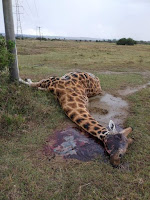KENYA GIRAFFE ELECTROCUTION URGENT CONCERNS TO IUCN COMMITTEE
ADDRESSED TO
INTERNATIONAL UNION FOR CONSERVATION OF NATURE - IUCN COMMITTEE.
Dated
23/02/2022.
As the world participate in the ongoing 5th United Nation
Environment Assembly UNEA5 Nairobi, Kenya:
We the Kenya
people, world citizens, international and national cooperate
entities environmentalists, ecologists, conservationists, parks
attendants, wildlife warriors and tourists. Primarily concerned by the
reports that in the past 2 Months over 11 Giraffes have been electrocuted by
electricity within Nakuru County-Soysambu Conservancy Area. Shocking that
Kenya Wildlife Service through a press statement dated 21st February 2021
casually seem to acknowledge 2 giraffes electrocution, how such electric power
cables were rerouted inside a conservancy and other parks countrywide some
along animal migratory paths could not be explained, the online photos of 3
dead giraffes indicates vilest
disfigured carcasses, photos circulate online, nearby communities
claim over 11 giraffes have befallen such fate.
THAT KENYA number of giraffes totals 28,850. The detailed breakdown of the same, indicates 12,717 Masai Giraffes, 15,524 are reticulated giraffes and 609 Rothschild giraffes.
HISTORICALLY
IN 1900 there was a
conference on conservation efforts in Africa, which produced the
convention for the preservation of wild animals, birds and fish in Africa.
THE SECOND
INTERNATIONAL CONFERENCE convened in 1933 London, a meeting which
produced convention for the protection of Africa Flora and Fauna its main task
on complex's classification of animals. Thus the age
of Africa National Parks began
with the international agreement of 1933 London Conference
THAT BETWEEN
1940 TO 1970 , Seven protected areas were established -Nairobi
National Park, Ambosseli, Tsavo National Park and Masai Mara National Reserve,
Serengeti, Tarangire, and lake Manyara National Park in Tanzania.
KENYA is signatory state to CITES-Convention on
International Trade in endangered Species of Wild Fauna and Flora-
and designated Kenya Wildlife Service, the CITES Management Authority and CITES
Scientific Authority as its representative.
WE ARE
CONCERNED with triggers towards some extinction of Big Five
animals in Kenya and East Africa region, especially now desert locust are
swarming in our region, this mandate we believe falls within the
IUCN Red List and Green Status of Species which was adopted in 1993 through
Convention on Biological Diversity.
THE RESOLUTION
WCC-2012-RES-41,by Kenya Government to International Union for Conservation
of Nature IUCN Red Lists of threatened species, which indicated some
species and ecosystems being lost and the protected areas being
degraded, similar to Soysambu Conservancy.
NOTING that the extinction of species and
the diminution of their populations both contribute to biodiversity
loss, and that this loss leads to degradation of natural ecosystems and to a
decline in the provision of ecosystem services.
ACKNOWLEDGING the
invaluable role played by the IUCN Red Lists in assessing the extinction risk of species and risk of collapse
of ecosystems, and of the IUCN World Commission on Protected Areas (WCPA) in promoting the
good management of protected area systems globally.
We therefore
DEMAND:-
- We demand
immediate sacking by the appointing authority the Kenya Wildlife
Service- Director General-Brig.(Rtd) John Waweru, the KWS Board of
Directors, Board of Trustees, members Kenya Office CITES Management
Authority and Kenya Office CITES Scientific Authority.
- Urgently request
a detailed report from the the secretariat of
Convention on biological diversity the measure government of Kenya is
undertaking towards protection of wild animals focusing especially
grassland and herbivorous in Kenya, inline to the ongoing locust invasion
to their habitat and countermeasures of government initiative
on chemical aerial spraying .
- We demand
within 21 Days the Director of Public Prosecution to launch a
criminal proceeding against all the parties involved through Wildlife
related offences.
- We demand for status of
shared natural resources and benefits accrued from tourism towards local
indigenous communities especially communities residing within protected
areas, that is Maasai, Samburus, Redille, Borana, Mijikenda,Turkana and Teso
community.
- We demand
updated assessments, audit and status of Geographic Information
Systems (GIS) surveys of all Parks, Games Reserves, Conservancies,
National Museum, Animal corridors and Marine in Kenya and East
Africa region supported by the CITES secretariat through the relevant
committees in collaboration with Kenya Rangeland Ecological Monitoring Unit
(KREMU)
- We demand
President Uhuru Kenyatta to reinstate NEMA (EIA Levy), Parliament
establish a minimum Environmental Assessment Charge and its increment from
(0.1 % to 5%) of standardized total project cost.
- We demand
the National Assembly to review and Fastrack the environmental
impact assessment and Audit amendment regulation 2016, gazette dated 19
August 2016 via special supplement no 137I.
- We demand the fastracking of
two interrelated Bills 1. The Wildlife Conservation and
Management (Amendment) Bill ( Senate Bills No.4 of 2019) a bill stuck
before Senate Committees on land ,environment and natural resources
awaiting second reading.
- We call for a uniformed
coherent Public Participation Bills- (Senate Bill No.4 of 2018) Public
Participation Bill-(National Assembly) Bill No 69 of
2019 and the Public Participation Bill No.79 of 2019.
- That this
bills seek to provide framework for Public Participation, defining
parameters of accessing public participation effectiveness, the
obligations of state organs and public offices, creating effective
community participation in decision making processes.
Dated this 23 Day of February, 2021.
By East Africa Climate Change Network and Baraza La
Taifa.
Copied to:-
World Commission
on Protected Areas Contacts
UNECOSOC Secretariat ecosocinfo@un.org
Kenya Widlife
Service email.kws@kws.go.ke
Inspector General
of Police
The National
Treasury
Ministry of
Tourism and wildlife-state department of wildlife
Ministry of
Interior and Cordination of National Government.
European Union
Biodervesity Conservation program.
IUCN Species survival commission
Frankfurt
Zoological Society.
George Adamson
Jane Goodall @JaneGoodallInst
Sierraclub @SierraClub
Royal Geographic
society
African Parks @AfricanParks
London
Missionary society
New York herard
Glasgow herard
Global wildlife
conservation
Joseph Conrad
Fauna
preservation society
East african
wildlife society
IUCN- UNESCO @IUCN






Comments
Post a Comment